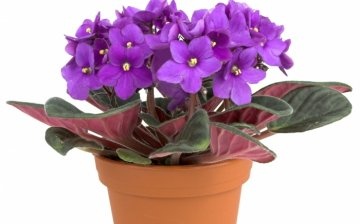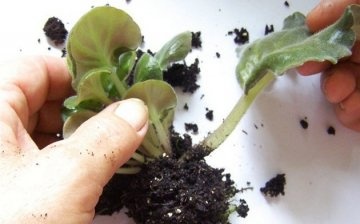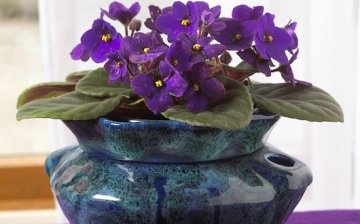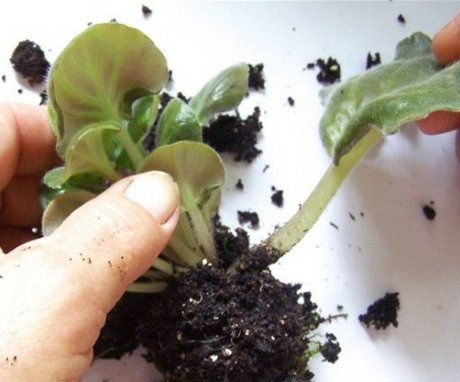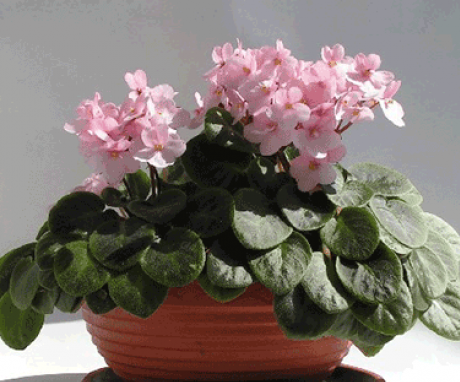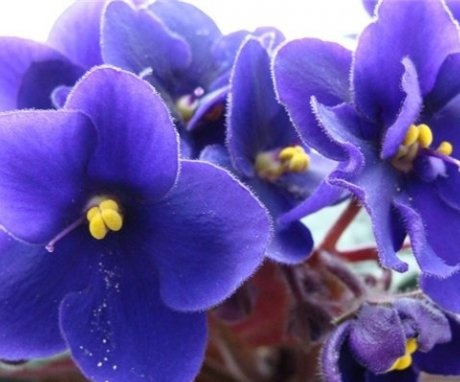How to properly care for indoor violets
Those beautiful, miniature indoor flowers, which we used to call violets, have the scientific name Uzanbar Saintpaulias. This is one of the favorite and most common indoor flowers that adorn almost every window sill. Caring for them is easy if you treat the plants with love.
Content:
- General description and history of violets
- Reproduction of indoor violets
- Features of caring for indoor violets
- How to make room violets bloom
- What you need to know when buying a room violet
General description and history of violets
To understand where this name came from, you need to delve into history. In the 19th century, a German colony was located in East Africa. Once the young Baron von Saint-Paul with his bride tried to hide from the scorching sun in the mountains of Tanzania. There, among the mossy stones, he found an amazing purple flower and gave it to his father. As you may have guessed, the flower will receive its name "saintpaulia" in honor of the baron. After this incident, the flower was brought to Europe from East Africa.
In Africa, Saintpaulia has been known for a long time. At that time already existed about 20 types of this plant. Some flowers reached a height of 30 cm.
The indoor violet quickly became popular due to its bright double or smooth flowers, unpretentiousness and long flowering (under the right conditions of care, Saintpaulia blooms for almost a year - 10 months).
Flowers can have a wide variety of colors, although purple and white are more popular.
There are also multi-colored variegated species. The leaves of indoor violets are dark green, oval, velvety. At first glance, it may seem that indoor violets and caring for them is a simple matter. But to achieve a long flowering, you will have to make some effort.
It is believed that Saintpaulias not only decorate the house and delight the eye, but also fill the home with positive energy. Where there is a room violet, an atmosphere of calmness and tranquility reigns. And if you put such a violet in the children's room, it will help children learn responsibility. Saintpaulia, placed in the bedroom, not only gives calmness, but also develops laziness. If you do not want to lie in bed all day, do not put a violet there.
Reproduction of indoor violets
One of the most common breeding methods for indoor violets is leaf rooting. To do this, you need to do the following:
- Take an adult healthy plant and tear off the densest and strongest leaf, but not at the very root, but in the second row from the bottom.
- Put this leaf completely in a container with boiled water and potassium permanganate for a couple of hours.
- After that, dry the sheet and make a small neat cut with a blade on the handle at a distance 3 cm from the sheet plate.
- Then take a small bottle with a narrow neck. Pour clean or boiled water there and add activated charcoal. The bottle must be clean. It is advisable to sterilize it before that. Submerge the cutting in the water so that the tip does not touch the bottom of the bottle, but is still in the water.
- There is no need to change the water in the bottle; it is enough to top up as needed. Do not hold the cutting for long after cutting.The sooner you put it in the liquid, the earlier the first roots will appear. If you notice traces of rot on the cutting, remove it and repeat the cut, and then put it back in clean water in a sterilized container.
- Roots may appear in a week, or in a month. It all depends on the variety of violets. Remember to sign the dates when you pruned the cutting and when you planted it in the soil. When the roots reach 2 cm, you can plant a violet. For starters, you can use a disposable cup for this purpose. Planting soil can be purchased at specialized floriculture stores.
- Don't forget about drainage. Foam can be used as drainage. It is not necessary to deeply deepen the cutting into the ground. After the cutting is planted, gently water it with lukewarm, settled water and place it in a warm place, but not in the bright sun.
If you want to save time, plant cuttings you can directly into the ground. This breeding method can be said to be more effective than rooting in water. The cuttings are immediately in a favorable soil environment, they do not need to be transplanted, the roots begin to grow faster. Some varieties of violets do not give roots well in water, then you can immediately resort to this method of propagation.
Even the leaves of very young violets can be planted in the ground for rooting.
You need to plant in a plastic container. Be sure to put drainage on the bottom. Make a small hole, add perlite there and plant a cutting. Perlite will allow air to flow to the root formation.
Features of caring for indoor violets
No wonder there is an expression "tender as a violet". These fragile flowers require special care. If you provide them with the necessary conditions, Saintpaulia will delight you with flowers for a very long time.
Required temperature for violet growth:
- Despite the fact that this plant was brought from Africa, they feel best at an average temperature of +20 degrees.
- In order for the plant to grow well, at night the temperature should be slightly lower than daytime, by 2-3 degrees. In this case, the process of tissue respiration slows down, and organic matter is saved.
- If these are very young violets, just planted, the temperature can be raised to 25 degrees.
- Violets tolerate coolness better than stuffiness. If the temperature drops to +10, the saintpaulias will only slow down their growth, but they will completely survive. But when the temperature rises to 35 degrees, they will start to hurt.
The lighting level depends from the violet variety. Lighting can be natural and artificial if natural is not enough. The darker the leaves of the violet, the more light it needs. If you are placing violets on a windowsill, use the north or east side. The need for light does not at all mean that you need to put the flower under the scorching sun.
Direct sunlight will burn the delicate leaves. The light should be diffused.
In winter, with insufficient light, you can put the violet on the south side. If the leaves of the violets lengthen and stretch, then there is not enough light. And if the leaves, on the contrary, bend over to the pot, then there is too much light. Unroll the pot periodically so that the rosette does not deform.
Watering violets:
- Water the violets very carefully and as needed. If you see that the top layer of the earth is dry, you can moisten the soil.
- The water should be slightly lukewarm.
- Can't pour water in the middle of the outlet.
- Make sure that the cuttings do not rot.
- Violet leaves should be periodically wiped with a damp cloth to remove dust. You can rinse them with a weak stream of water, but very carefully, trying not to fill the pot with soil.
- Wet leaves should not be in the sun, otherwise they will get burned. Let the flower dry in the shade.
How to make room violets bloom
A well-groomed healthy indoor violet blooms for up to 10 months a year, taking a break only for the hot months.To make your Saintpaulia delight you with flowers, follow a few simple rules:
- Don't plant a violet in a large pot. With an abundance of space and land, the roots of Saintpaulia grow too much. All the strength and nutrients go to the root system, but there is not enough strength for flowering.
- Violets are among the flowers that simply cannot do without drainage. Without it, the roots begin to rot due to waterlogging of the soil.
- Do not take soil in flower beds on the streets. This land can be infested with pests. It is better to buy soil from a gardening store. A universal primer or a special one for Saintpaulias will do.
- Only those violets that are provided with diffused light bloom. If the sun is too bright, hang a mosquito net or translucent cloth over your windows.
- Remember the temperature too. If the violet is in a draft, it will not bloom. The same goes for extreme heat. The temperature should be optimal.
- When watering, make sure that the water does not get on the flowers, they die from this. The most optimal watering option is to pour water into the sump. This will prevent injury to delicate leaves and flowers.
- Fertilizers are needed, but in moderation. You don't need to feed the violet more than once a month. If you overdo it with fertilizers, the leaves will begin to turn yellow and fall off.
- In order for the violet to bloom beautifully and regularly, do not forget to take care of the outlet. Withered and dried flowers must be removed, then the rest will bloom more magnificently. Withered leaves also need to be removed.
- Small rosettes that form next to the main plant take away strength and nutrients from the "mother". If you want to see a lush bloom, remove them.
- If the foliage is too thick, it needs to be thinned out.
- Constantly turn the flower in different directions towards the light. So the rosette will be uniform and beautiful, lush from all sides.
- If, despite your best efforts, the violet still does not bloom or does not bloom well, check the soil for acidity. In acidic soil, many indoor plants refuse to bloom.
- Do not forget to moisten not only the soil, but also the air. If you don't have a moisturizer, a simple gentle sprinkling of the leaves will do.
What you need to know when buying a room violet
Indoor violets are not cheap pleasure. Therefore, before buying, stock up on all the necessary information on how to choose the right Saintpaulia.
Many people try to buy a beautiful blooming violet in the store in the hope that it will always bloom the same way. However, the violet is an unpredictable and changeable flower. You cannot know if the saintpaulia will bloom the same next year, or if it will have to be thrown away after flowering. The second option is more common. Therefore, if you buy a violet not as a gift, do not attach so much importance to the flowering species. Buy a cutting. It will quickly take over, and you can plant a few more daughter flowers that will form later.
Take a close look at the photos on the Internet, choose the variety you like and read everything about caring for it. It will be difficult to tell from the cut if this is really the variety you asked for and whether it will look like the one in the photo on the Internet. Ask the seller about the flower in detail.
Buy cuttings only in proven specialty stores, not on the street.
Most likely the seller will offer you a plastic container for the cutting. But if there is none, wrap it in cellophane and carry it very carefully. Try not to break or damage the plant. If any piece of paper breaks off, remove it immediately.
If you buy several cuttings of different varieties, ask the seller to put each in a separate container and sign them so as not to confuse them in the future. Ask well everything that interests: when it blooms, does it have the color that you expect, what kind of soil is better to use. Examine the cutting carefully. There should be no stains or traces of rot on it.
If you do buy a blooming violet, it is also necessary inspect for damage and disease:
- Leaves should not be yellow, lethargic, or elongated.
- The outlet should be flat, lush and beautiful.
- Check the soil as well. Is there any suspicious plaque or stains on it?, midges.
If you buy a violet for a birthday or other holiday as a gift, you will not pay attention to the time of year. But if Saintpaulia is for you, try to buy it in the spring. In extreme heat or cold, the violet may have diaper rash on the roots, or they may be frozen, which you will not be able to notice right away.
More information can be found in the video.



